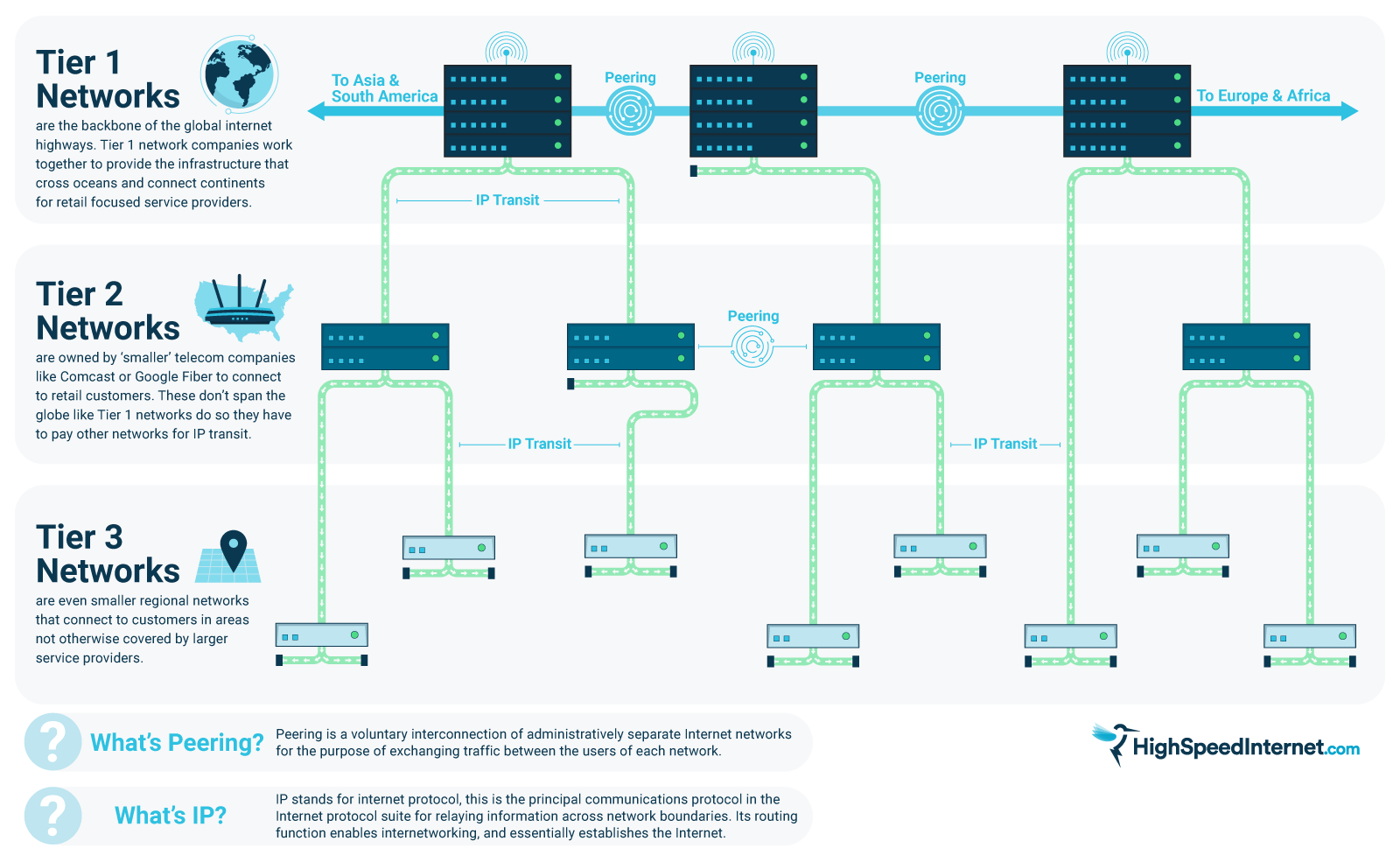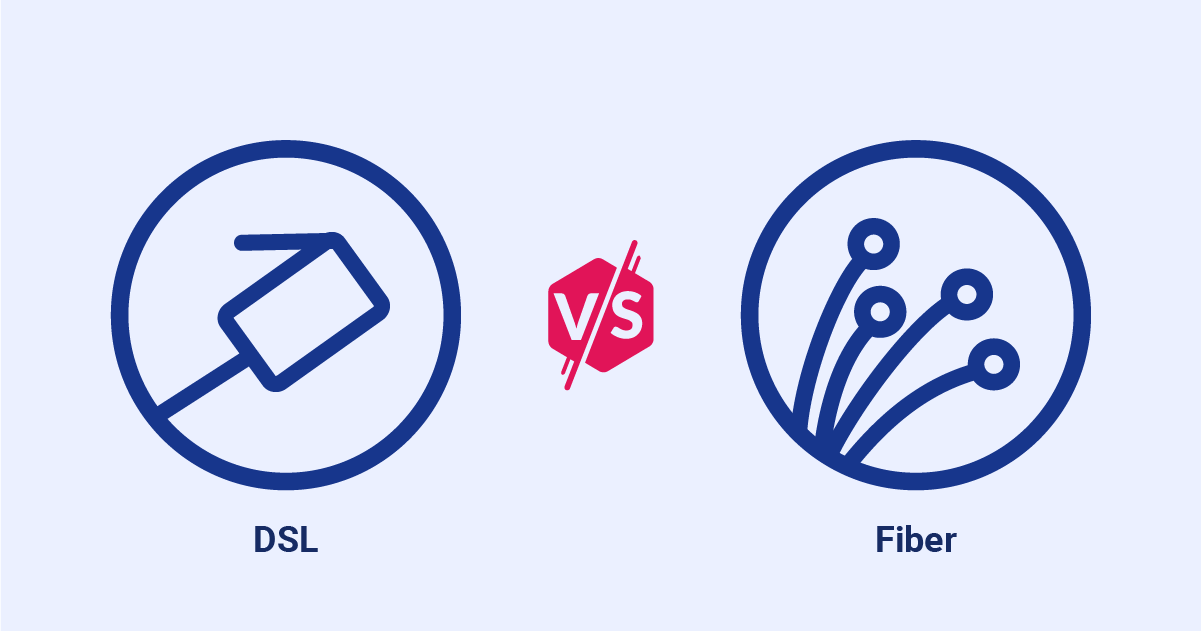Why Can I Only Get a Few Internet Providers?
Nov 11, 2021 | Share
FAQ, Technology
The number of broadband internet options in the United States is limited compared to other countries due to deregulation in the 1980s and 1990s, as well as a lack of public investment in broadband infrastructure.
This might seem counterintuitive, since the internet was born in the US through government-funded research, but a lot has changed over the last 50 years. To illustrate, we’re going to take a closer look at the modern internet landscape to help you better understand the internet service in your area.
There are a few places in the US with a wide selection of internet service providers (ISPs), such as Los Angeles, New York, and Kansas City. But many cities have only one or two providers, and between 21 and 41 million Americans don’t have access to high-speed internet at all.1
Compare this with countries like South Korea, where internet connections are on average twice as fast and cost less than $30 a month.2, 3 Why does the US lag so far behind?
How does the internet get to your home?
Although we often talk about the internet as being some ephemeral, incorporeal thing like a rainbow or a shadow, it is also a massive system of physical devices—including cables, lasers, transmission towers, utility poles, and underground tunnels. All this stuff is owned by someone, and it takes a lot of money to maintain and expand it.
The structure of the internet is a bit like highways, and the backbone of the internet is made up of Tier 1 networks. Tier 1 networks consist of the huge fiber-optic cables that cross oceans and connect continents.4 They’re owned by the biggest telecom companies—like AT&T and CenturyLink in the US and Deutsche Telekom in Germany—but no one has to pay to send data over them.18 These are like the freeways of the internet—big, fast, and free to use . . . once you’re on them, that is.
Below these are the Tier 2 and Tier 3 networks, owned by smaller telecom companies like Comcast and Google Fiber (it’s odd to refer to any part of Google as being a “smaller company”). Although some of the Tier 2 networks connect together freely, they don’t span the globe like Tier 1 networks, so they have to pay other networks for IP (internet protocol) transit.4

IP transit deals are a bit like home internet plans, but rather than simply giving a network access to the rest of the internet, it makes them part of the internet, allowing traffic to cross in and out of their network and through their equipment. Most of these networks belong to small- to mid-sized ISPs, but governments, universities, and research groups will also make transit agreements to connect their already large networks to the rest of the interent.4
All these large, constituent parts of the internet are built using fiber because fiber is great. Below these various tiers of internet networks is what’s called the “last mile.” This is the part that actually connects the wider internet to your home. In the US, most of the last mile is not fiber but a mix of different technologies, like cable, DSL, and fixed wireless.
Broadband coverage in the US
Measuring broadband coverage in the US can be a bit tricky. One reason is because almost 100% of the population has access to satellite internet providers, which makes nationwide broadband coverage look great.
While satellite internet is an invaluable resource that provides internet access to millions of people, it’s also one of the slowest and most expensive types of internet. Low data caps and high latency make it impractical for many online activities.
When we look at broadband coverage in the US while excluding satellite internet, we get a very different picture.19
| No providers | 1+ providers | 2+ providers | 3+ providers | |
|---|---|---|---|---|
| Rural | 14.60% | 85.40% | 47.77% | 16.13% |
| Urban | 1.09% | 98.91% | 83.21% | 36.22% |
| All | 3.75% | 96.25% | 76.23% | 32.26% |
While over 96% of the US population has access to broadband internet of some kind, this number drops to 85% in rural areas. Lack of competition is also more pronounced in rural areas, as fewer than half of rural customers have more than a single choice of broadband provider (which is another reason why satellite internet is so important to rural areas). Even in urban areas, only about a third of internet customers have more than one or two choices.
How can rural customers find more providers?
Rural communities often have the fewest options for internet service providers because companies have less of an incentive to build out expensive networks in areas with lower population density. Cable networks often don’t penetrate into rural areas, leaving only DSL providers, if you’re lucky. The good news is that satellite internet from Viasat and HughesNet is available nationwide for rural customers, and up-and-coming providers like Starlink promise to make rural internet faster and more available than ever before.
All you need to get a satellite connection is somewhere to install a dish that has a clear view of the southern sky. Satellite connections are as slow as DSL, have much higher latency (making them feel even slower), and are often much more expensive, but they’re always there as a last resort.
If you live in a rural area, you can also explore getting internet from a mobile hotspot, a fixed-wireless connection, or a 4G LTE provider. Learn more about rural internet options.
Why are there so few internet providers even in urban areas?
With a massive superhighway of lightspeed information within walking distance of most people’s homes, it seems like getting fast, affordable access to the internet should be easy if you live in the city. Instead, the US lags behind other countries in terms of internet speed, not even placing in the top ten.2 Why don’t ISPs bother improving their “last mile” networks to match the rest of their superfast fiber infrastructure?
The simple answer is that there’s not enough economic pressure to improve aging networks. As part of the recent Frontier Bankruptcy, Frontier has given us an incredibly detailed description of its finances and decision making. Although the company knew that fiber was the best long-term investment, it had little motivation from competitors, so instead it chose to put off those improvements until it was too late.5
Like Frontier, many other ISPs were slow to the fiber game until they got a push. When Google Fiber was announced in 2010, the response from cities across the country was overwhelming, with well over 1,000 cities clamoring to test out the service (Google was expecting between 10 and 50). Although Google Fiber has struggled to compete with established ISPs, the Harvard Business Review has credited the massive expansion of fiber networks by AT&T, CenturyLink, and even Frontier to competition from Google Fiber.16 While fiber-to-the-home has expanded over the years, it’s still a neglected portion of the US internet infrastructure simply because of how expensive it is, making it difficult for the majority of Americans to take advantage of its speed.
Why are there so few internet providers?
There are only a few internet providers in the US because all the smaller providers merged together to become (or were bought out by) huge nationwide companies, which are now difficult to challenge. When US telecommunications law was updated to deal with new technologies like cable TV and later the internet, both these laws had explicitly stated goals of promoting competition in telecom markets and encouraging the growth and expansion of the networks themselves.6, 7 Instead of promoting competition between ISPs, these new laws allowed a flurry of mergers and acquisitions that reduced the telecom industry to just a handful.
Since nationwide ISPs cover huge areas and have few competitors, there’s little motivation to spend millions of dollars on expanding that network to move to a new area where there’ll be more competition. It’s also hard for new companies to enter the broadband market, since their competitors control all the infrastructure, leaving them to start from scratch. Google Fiber is one of the few new ISPs that have had the resources to compete with the existing telecom companies, and even Google found itself being blocked at every turn.15
Internet availability and the digital divide
No one wants to pay more for less download speed. This issue has become even more important since the COVID-19 pandemic, as many day-to-day activities have moved online. When jobs, school, and medical care depend on the internet, you can hardly afford not to have an internet connection. It’s no longer just a convenience—it’s a necessity.
This difference between people with access to affordable internet and those without is often referred to as the digital divide. Those without access to fast, reliable internet miss out on opportunities for education, higher paying jobs, and civic engagement. In many cases, they can still be paying as much or more for their slow internet connections as people with faster connections in areas with more options and more competition between providers.
Fortunately, many people in politics, academia, and the tech industry are trying to bridge the digital divide. For example, in July 2021, President Biden issued an executive order instructing the FCC to prevent certain anticompetitive practices from ISPs, make their pricing more transparent, and limit excessive early termination fees.20 If implemented by the FCC, it would improve access to the internet in many low-income communities.
How to get more internet providers in your area
The best way to get internet providers to expand their networks into new areas is to increase the amount of competition in the internet market. There are several ways to do this:
- Discourage anticompetitive practices
- Invest in open networks
- Deregulate competitive markets
- Encourage public-private partnerships
Discourage anticompetitive practices
By hogging space on public utility poles, filing frivolous lawsuits, or simply buying up potential competitors, ISPs have made it nearly impossible for anyone to challenge them.
Although this is the exact opposite of what lawmakers had intended US telecom law to do, there is increasing public interest in fixing internet law, as seen in the recent and ongoing battles over net neutrality and privacy laws. And, to be fair, the FCC has undertaken several initiatives to this end, such as the Rural Digital Opportunity Fund and the Broadband Deployment Advisory Committee.8
Telecom law should never enable practices that disempower consumers. We should be paying for services because we want them, not because all our other options were taken away.
Invest in open networks
State and local governments have also taken the initiative to improve internet infrastructure. New York City recently announced a plan to bring universal broadband to all its residents, creating an open-access fiber network that could be shared by multiple providers rather than a single ISP, allowing customers to choose who they wanted to buy their internet service from.9 This shared fiber network would essentially make the last mile of the internet function a lot more like its upper tiers.
Open networks are the norm in South Korea, Japan, and many European countries.10, 11 Not coincidentally, these countries have some of the fastest and cheapest internet connections in the world.
Deregulate competitive markets
While it would be nice to simply pass a law to fix the internet in the US, many internet regulations have done more harm than good. Almost half of US states have laws restricting or prohibiting the development of municipal broadband—high-speed local networks built by cities.12 Municipal broadband currently provides the fastest connection speeds in the country,13 but it can also be the seed for encouraging other companies, like Google Fiber, to enter an area.14
Municipal broadband networks bring more choices, more competition, and higher speeds to communities—especially smaller communities that are stuck with only one or two choices in their area. Many communities want to invest in their public infrastructure but are prevented from doing so by anticompetitive laws.
Encourage public-private partnerships
Countries with the fastest internet speeds, like South Korea, didn’t simply build this infrastructure with public funds—the private sector played an equally important role. Korean telecom companies invested billions into building high-speed fiber networks, but the government was always involved and required infrastructure sharing in order to incentivize new companies to enter the market.3
Private sector competition can cause explosions of new growth in the US too. The most notable example of this is Google Fiber. Even Google struggled to push into the broadband market as the tech giant’s efforts were stalled by lawsuits from existing telecoms.15
Despite being practically run out of the market, Google Fiber is still cited as the inciting force behind other providers’ moves toward expanding their fiber networks.16 Imagine how much faster broadband infrastructure could be if fiber companies without the financial backing of a company the size of Google could break into the market.
What can we do now?
Expanding competition in the US broadband market will be a slow process, but public awareness plays an important role. There are a few things you can do to work toward getting more internet provider options:
Raise awareness—The debate over net neutrality shifted dramatically based on public outcry and concerted efforts of citizens contacting their representatives.17
Demand better service—As customers demand more choices and better connections in the broadband market, we can push the conversation toward the kind of public-private partnerships that have rapidly expanded broadband access in other countries.
Support local providers—Smaller providers often provide service tailored to their community, such as providing fixed-wireless connections to parts of the city that fall between the cracks of bigger networks, or providing high-speed fiber connections for business internet.
Bottom line: We need more competition in broadband internet
As large internet providers have settled into comfortable niches where they have little to fear from competitors, the growth of broadband infrastructure in the US has ground to a halt. This is in direct opposition to the stated goals of US telecommunications law and needs to be addressed.
As initiatives like Google Fiber have shown, ISPs are perfectly capable of delivering better speeds and better service with the right motivation. On the other hand, as we’ve seen from the Frontier bankruptcy, if we focus only on short-term gains and don’t make long-term investments in the future, everybody loses.
If you want to make a difference in your area, you can attend your local city or community council meetings and make broadband infrastructure a priority. Many of the FCC’s broadband programs are specifically targeted toward rural Americans, so there’s a lot of potential for growth if your town makes it a priority. Many of the cities that have implemented municipal broadband programs are fairly small, so you don’t need to be a major urban center to build a decent broadband network.
- Linda Poon, Bloomberg City Lab, “There Are Far More Americans without Broadband Access Than Previously Thought,” February 19, 2020. Accessed September 27, 2020.
- Alexandra Mosher, USA Today, “Superfast Internet? South Korea Wins, U.S. Lags Far Behind,” June 30, 2016. Accessed September 27, 2020.
- Jane Lee, Public Knowledge, “Why Does South Korea Have Faster Internet for a Cheaper Price Tag?”
- J. Steman, Datacenter.com, “Internet Service (Carrier) Provider Tiers – Tier 1, Tier 2, and Tier 3,” January 18, 2019. Accessed September 28, 2020.
- Ernesto Falcon, Cory Doctorow, and Katherine Trendacosta, EFF, “Frontier’s Bankruptcy Reveals Why Big ISPs Choose to Deny Fiber to So Much of America,” April 30, 2020. Accessed September 28, 2020.
- Michael I. Meyerson, Georgia Law Review, “The Cable Communications Policy Act of 1984: A Balancing Act on the Coaxial Wires,” 1985. Accessed September 29, 2020.
- Hanlong Fu, David J. Atkin, and Yi Mou, Advances in Communications & Media Research: Volume 8, “The Impact of the Telecommunications Act of 1996 in the Broadband Age,” October 2011. Accessed September 29, 2020.
- FCC, “Bridging the Digital Divide for All Americans,” Accessed September 29, 2020.
- Jon Brodkin, Ars Technica, “NYC Broadband Plan Calls for Fiber Everywhere, with ISPs Sharing Network,” August 1, 2020. Accessed September 29, 2020.
- Eun-A Park and Richard Taylor, Telecommunications Policy Research Conference, “Barriers to Entry Analysis of Broadband Multiple Platforms: Comparing the U.S. and South Korea”, September 29, 2006. Accessed September 29, 2020.
- John D. Sutter, CNN, “Why Internet Connections Are Fastest in South Korea,” March 31, 2010. Accessed September 29, 2020.
- Eric Griffith, PC Mag, “Cheap and Fast Municipal ISPs Are Blocked in Almost Half of the US,” May 18, 2020. Accessed September 29, 2020.
- Eric Griffith, PC Mag, “The Fastest ISPs of 2020,” June 12, 2020. Accessed September 29, 2020.
- Dave Smith, International Business Times, “Google Fiber In Utah: Why Provo Sold Its $39 Million Internet Service To Google For Just $1,” April 19, 2013. Accessed September 29, 2020.
- Jon Brodkin, Ars Technica, “AT&T Admits Defeat in Lawsuit It Filed to Stall Google Fiber,” November 1, 2017. Accessed September 29, 2020.
- Blair Levin and Larry Downes, Harvard Business Review, “Why Google Fiber Is High-Speed Internet’s Most Successful Failure,” September 7, 2018. Accessed September 29, 2020.
- Katharine Trendacosta and Ernesto Falcon, EFF, “Victory! The House of Representatives Passes Net Neutrality Protections,” April 10, 2019. Accessed September 29, 2020.
- Definitively categorizing ISPs into a specific tier is difficult because it makes assumptions about whether two ISPs have made an agreement for either peering or transit. The specifics of these agreements are not public, thus, most categorization involves some degree of speculation.
- FCC, “Fixed Broadband Deployment,” Accessed April 14, 2021.
- The White House, “FACT SHEET: Executive Order on Promoting Competition in the American Economy,” July 9, 2021. Accessed November 15, 2021.
Author - Peter Christiansen
Peter Christiansen writes about satellite internet, rural connectivity, livestreaming, and parental controls for HighSpeedInternet.com. Peter holds a PhD in communication from the University of Utah and has been working in tech for over 15 years as a computer programmer, game developer, filmmaker, and writer. His writing has been praised by outlets like Wired, Digital Humanities Now, and the New Statesman.
Editor - Cara Haynes
Cara Haynes has been editing and writing in the digital space for seven years, and she's edited all things internet for HighSpeedInternet.com for five years. She graduated with a BA in English and a minor in editing from Brigham Young University. When she's not editing, she makes tech accessible through her freelance writing for brands like Pluralsight. She believes no one should feel lost in internet land and that a good internet connection significantly extends your life span.





